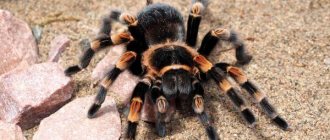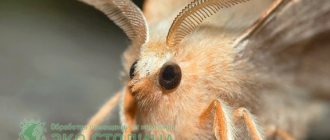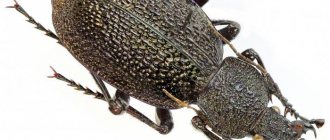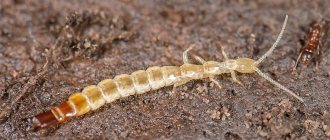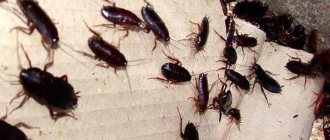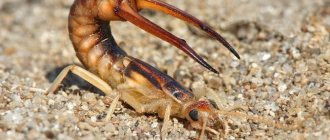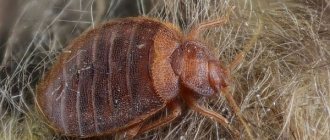- Home page
- Useful
- Differences between clothes and food moths
Almost every person is familiar with insects, which, being a constant companion of a person, cause considerable damage to him. From time to time, small annoying moths appear in living spaces and try to fly into kitchen and wardrobes. They constantly fly around the rooms.
These moths are moths in their final phase. Not everyone knows that there are two types of moths: food moth and clothes moth. Both of them are among the most common household pests, which are very difficult to combat. The fact is that moth larvae are very well camouflaged and hidden, so their detection is difficult.
In order to successfully combat these pests, you need to know how clothes moths differ from food moths, what are the features of their life cycle, how to prevent and control their appearance in a residential area.
What does a thing moth look like (photo)
Clothes moth.
Reasons for appearance
Of course, it is impossible to name clear reasons for the appearance of moths in apartments and elevators. The distribution of insects has characteristic differences. Different types of moths penetrate through their own, known only to them, paths to their favorite habitat. Although there are similarities:
- Penetration through open, unprotected windows, doors, ventilation ducts. They fly mainly towards the light.
- Brought in with things when moving contaminated products, seeds and plants.
- Brought on clothing or pet fur.
Main characteristics of the pest
Name: House moth Lat.:
Tineola bisselliellaClass: Insects - Insecta. Order: Lepidoptera - Lepidoptera. Family: True moths - Tineidae.
| Habitats: | cabinets, furniture |
| Dangerous for: | fabrics, furs, upholstery |
| Means of destruction: | traditional methods, chemicals, traps. |
Moth caterpillars.
Many people mistakenly believe that if their home is kept in order and clean, then these pests are not afraid of them. But in vain, because moths do not start from dirt.
She loves things made from natural fabrics such as wool and fur. She does not disdain cereals or other loose ingredients left unattended in the kitchen.
Such components are present in every home, so you need to always be on guard. In addition, if there is a moth in a neighboring apartment, then it is possible that it can get into the home through open doorways, vents, or cracks.
You can bring it with purchases from the store, with things or furniture that were used by other people.
What does it look like and where does it lay eggs?
The clothes moth looks like a fairly large butterfly. Its wingspan reaches 23 millimeters. The color of the wings is predominantly sandy, with a purple tint at the base.
She lays eggs in dark, hard-to-reach places, in folds of fabric, under collars and cuffs, in pockets, and in the recesses of textile seams.
Life cycle
The complete development cycle from egg to butterfly takes from one to two and a half years. Having hatched from the pupa, the butterfly immediately looks for a sexual partner and mates. In two weeks she lays about 50 eggs. After laying eggs, which takes seven days, the female lives for a few more days and dies. The male continues to mate until the end of his life.
Life cycle of a moth.
Damage
Moth damage on clothing.
Adult larvae crawl on clothes and furniture. The most dangerous are only the larvae that hatch from the eggs. They destroy and chew everything in their path, even synthetics and plastic bags.
Once the toothy larva has reached the item, all that remains is to throw it away. Such things, as a rule, cannot be restored.
What does it eat?
Clothes moths usually live in closets, furniture, attics, pantries, and anywhere there are fabric-upholstered items and clothing. Their favorite food is fur coats, woolen items, linen, cotton, natural angora, silk, and cashmere.
food moth
So, first of all, you need to understand that moths do not appear in apartments out of nowhere. There is an opinion that they appear in apartments where they do not maintain cleanliness, in other words, they appear from the dirt, but this is a completely erroneous opinion. Often, infection occurs because a person himself brings these insects to his home.
A fairly common situation is when the owner or mistress brings pests with purchased products, which may contain clutches of eggs, larvae and cocoons. Unfortunately, storage rules are not always followed in warehouses, which leads to contamination.
In addition, products that are sold by weight are most susceptible to contamination. But you shouldn’t think that plastic or paper packaging protects the contents, since insects can easily gnaw through it and get inside.
Moths can also fly into an apartment through open windows. Since they are nocturnal and prefer to hide in secluded corners during the day, they are attracted to bright lights in windows in the evening. They can also enter an apartment through ventilation openings, often in this way they move to new territories from neighbors.
You should be very careful when choosing products; you should not give preference to those that are sold at reduced prices, as this is an attempt to sell low-quality goods.
Products that may be affected by food moths:
- Cereals.
- Cereals.
- Flour.
- Dried fruits.
- Nuts.
- Seeds.
- Plants' seeds.
- Dried herbs.
- Pet food.
When purchasing these products, be sure to inspect them for the presence of pests. Also, after purchasing, they should be poured into containers that are hermetically sealed, which will not allow the female to get inside and lay eggs. In addition, if a product is contaminated, sealed packaging will prevent insects from getting to the surface and infecting other products.
How to get rid of clothes moths
It is quite difficult to remove clothes moths. Moreover, considering the fact that caterpillars can go without food for a month. There are folk, chemical and professional means of insect control.
Regular monitoring
In order to minimize the risk of invasion, regular inspections are carried out in cabinets and shelves. Both butterflies and larvae cannot exist without giving themselves away. In their habitats there will certainly be damaged areas of tissue, gnawed pieces of fur, threads of cobwebs, cocoons and feces.
If you suspect the presence of unwanted guests, you should react immediately, otherwise trouble cannot be avoided.
Preventing or reducing infestations
Cleaning a living space infested with clothes moth larvae should be carried out with special care.
- It is necessary to pay attention to hard-to-reach places: behind radiators and ventilation holes, under baseboards and wardrobes.
- Wipe shelves and furniture with a special disinfectant.
- When using a vacuum cleaner, upon completion of work, you must immediately dispose of the contents of the dust collection bag so that the larvae and eggs that get there cannot return again.
If moths are found in a closet, you should remove all items from there and wash all surfaces.
Protecting things in the closet
Sachet for the closet.
Clothes and other items left in the closet without proper care are most susceptible to insect attacks.
Therefore, they should be stored in clean, dry form, in sealed containers, pre-treated with natural repellents, for example, mint, lavender, wormwood, or use special chemicals, dichlorvos.
Freezing and heating
Moths do not like low or high temperatures.
Moth butterflies die when there is a sharp change in temperature, and it does not matter in which direction this difference occurs. This could be temperatures above 50 or below 20 degrees Celsius.
The product, previously placed in plastic packaging, is either fried in an oven or frozen in the freezer. It all depends on the type of fabric: if it is not afraid of these types of processing, then you can safely take them into service.
Dry cleaning will help get rid of moth larvae.
The contents of the closet are reviewed for damage, and surviving clothes are washed and fried at high temperatures. Bright sunlight is not a moth's best friend; it dies in the light.
Washing is done at a temperature of at least 50 degrees and for a duration of at least half an hour. Textiles that cannot be washed at high temperatures should be dry cleaned.
Traps
Sticky trap.
Another method of control is glue pheromone traps. This is the simplest, most accessible and relatively cheap method. The principle of its operation is very simple.
The female follows the smell emanating from the trap and sticks her paws to the glue, gets stuck there and dies. You can purchase it at any specialized institution.
Deliverance is possible
How to get rid of moths? This process is quite labor-intensive and requires a significant time investment. Today, the following methods are used to control and influence the moth population in domestic conditions:
- carrying out regular dry cleaning;
- wet cleaning (washing) of premises and utensils for storing bulk products;
- freezing or heating food;
- fumigation and use of insecticides.
Each of these methods has its own advantages. In addition, the effectiveness of moth control is significantly influenced by the general condition and management of the household, periodic monitoring of the storage conditions of things and products that are the most “tasty” morsels for moths.
During cleaning, it is necessary to use complex methods that combine detection, localization and destruction of foci of infection. An important place in the complex of measures to prevent the appearance of these pests is occupied by the timely identification of places where they are concentrated - various cracks in the walls, under baseboards, under furniture, and so on. It is advisable to store bulk products in airtight containers. Wearable items that are not worn often should be dried regularly in bright sun.
The use of various chemical means of control - the same naphthalene or essential oils (lavender, cedar) - brings very good results. Special moth traps based on pheromones released by the male moth are also effective.
Preventive measures
Folk remedies are often used as prevention.
Repellent plants are able to repel insects and moths with their specific aroma.
Their effect is longer than that of chemical drugs, but they are less dangerous to the health of people and pets. These include tobacco, garlic, vinegar, geranium, lily, mint, lavender, rosemary, citrus peel and many others.
Follow this link to learn more about all the ways to get rid of moths.
The effect of temperature on moths and their larvae
Cold weather also negatively affects the growth of larvae. At low temperatures, the larvae again decrease in size, return to the cocoon and remain hungry.
The eggs of house and furniture moths are white or light yellow in color, small in size, only half a centimeter. To lay eggs, the female chooses the best clothes and lays several dozen eggs there, so that later the larvae have something to eat. Within 5–6 days at normal temperatures, moth eggs are ready, but at low temperatures the process of egg maturation slows down. At a temperature of 0°C the larvae deteriorate.
Moth butterflies are short-lived. They live mostly for a couple of weeks and do not feed. For moth larvae that eat wool products, free movement through the fabric is difficult. That part of the threads that they do not eat, they simply gnaw, making a path for themselves.
Control and prevention measures
In industrial conditions, there are different measures to combat different species. However, they are often comparable to those used in apartment conditions.
First of all, of course, prevention against insects:
- Cleanliness and periodic disinfection. The best way out is to regularly inspect supplies for contamination, arrange cleaning: use a vacuum cleaner, ventilate and knock out textile surfaces.
- Periodically expose things to ultraviolet radiation, sub-zero or high temperatures.
- Prevent moths from entering through windows and doors, ventilation: it is enough to use nets.
- Ensure sealed storage of food products, purchase special covers for clothes.
- Hang or lay out insect stickies. In addition, you can, for example, lay out herbs that repel moths.
Control measures are perhaps much more difficult than prevention. If a threat has appeared, you need to act quickly to prevent mass infection. For this:
- A thorough audit of the contents of all cabinets and even sealed containers is carried out.
- Contaminated products are destroyed. Clothes and interior items must be dried, vacuumed, and beaten.
- Carry out general wet treatment of all surfaces.
- Use insecticides according to instructions.
Moths, despite their size, cause enormous consequences. Therefore, if you are not in the habit of spending your time on periodic revisions, ensure that things are stored correctly. Otherwise, the need for destruction will put the whole house on its head.
Features of reproduction
The moth essentially remains a butterfly, that is, it reproduces and lives in exactly the same way as all normal lepidoptera. True, it reproduces at home even in winter. A little slower, but still.
The life cycle consists of the following stages:
- Eggs. Depending on the species, the insect lays 40-500 pieces.
- Caterpillar. It is important to avoid this particular stage. After the larva has left the egg, it begins to actively gain vitality. This happens due to cereal stocks, clothing, furniture, carpets, etc.
- Pupae. Having properly accumulated energy, the caterpillar pupates and in this state forms into an adult.
- Imago. Directly moth. In principle, a harmless butterfly, if not for the purpose of all life - reproduction. An adult moth lives only for this: it does not even feed.
